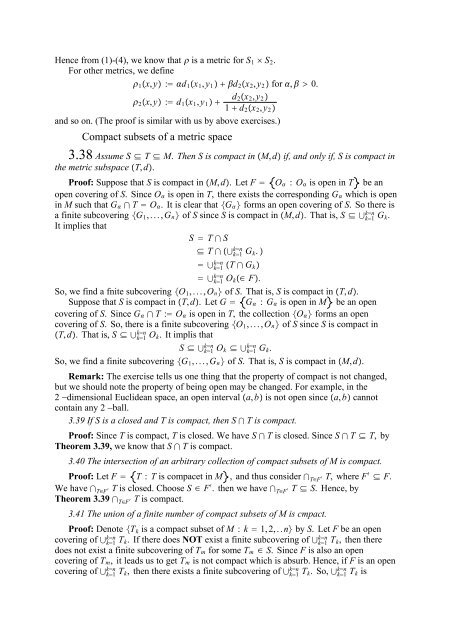The Real And Complex Number Systems
The Real And Complex Number Systems
The Real And Complex Number Systems
You also want an ePaper? Increase the reach of your titles
YUMPU automatically turns print PDFs into web optimized ePapers that Google loves.
Hence from (1)-(4), we know that isametricforS 1 S 2 .<br />
For other metrics, we define<br />
1 x, y : d 1 x 1 , y 1 d 2 x 2 , y 2 for , 0.<br />
d<br />
2 x, y : d 1 x 1 , y 1 2 x 2 , y 2 <br />
1 d 2 x 2 , y 2 <br />
and so on. (<strong>The</strong> proof is similar with us by above exercises.)<br />
Compact subsets of a metric space<br />
3.38 Assume S T M. <strong>The</strong>n S is compact in M, d if, and only if, S is compact in<br />
the metric subspace T, d.<br />
Proof: Suppose that S is compact in M, d. LetF O : O is open in T be an<br />
open covering of S. SinceO is open in T, there exists the corresponding G which is open<br />
in M such that G T O . It is clear that G forms an open covering of S. Sothereis<br />
a finite subcovering G 1 ,...,G n of S since S is compact in M, d. Thatis,S kn k1 G k .<br />
It implies that<br />
S T S<br />
T kn k1 G k . <br />
kn k1 T G k <br />
kn k1 O k F.<br />
So, we find a fnite subcovering O 1 ,...,O n of S. Thatis,S is compact in T, d.<br />
Suppose that S is compact in T, d. LetG G : G is open in M be an open<br />
covering of S. SinceG T : O is open in T, the collection O forms an open<br />
covering of S. So, there is a finite subcovering O 1 ,...,O n of S since S is compact in<br />
T, d. Thatis,S kn k1 O k . It implis that<br />
S kn k1 O k kn k1 G k .<br />
So, we find a finite subcovering G 1 ,...,G n of S. Thatis,S is compact in M, d.<br />
Remark: <strong>The</strong> exercise tells us one thing that the property of compact is not changed,<br />
but we should note the property of being open may be changed. For example, in the<br />
2 dimensional Euclidean space, an open interval a, b is not open since a, b cannot<br />
contain any 2 ball.<br />
3.39 If S is a closed and T is compact, then S T is compact.<br />
Proof: Since T is compact, T is closed. We have S T is closed. Since S T T, by<br />
<strong>The</strong>orem 3.39, we know that S T is compact.<br />
3.40 <strong>The</strong> intersection of an arbitrary collection of compact subsets of M is compact.<br />
Proof: Let F T : T is compacet in M , and thus consider TF<br />
T, whereF F.<br />
We have TF<br />
T is closed. Choose S F . then we have TF<br />
T S. Hence, by<br />
<strong>The</strong>orem 3.39 TF<br />
T is compact.<br />
3.41 <strong>The</strong> union of a finite number of compact subsets of M is cmpact.<br />
Proof: Denote T k is a compact subset of M : k 1, 2, . . n by S. LetF be an open<br />
covering of kn k1 T k . If there does NOT exist a finite subcovering of kn k1 T k , then there<br />
does not exist a finite subcovering of T m for some T m S. SinceF is also an open<br />
covering of T m , it leads us to get T m is not compact which is absurb. Hence, if F is an open<br />
covering of kn k1 T k , then there exists a finite subcovering of kn k1 T k .So,kn k1 T k is
















